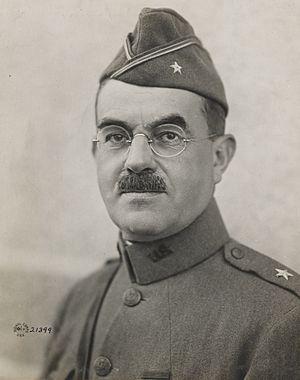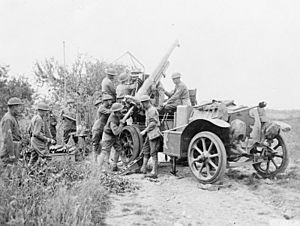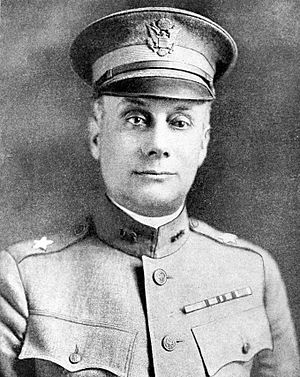James Ancil Shipton facts for kids
Quick facts for kids
James Ancil Shipton
|
|
|---|---|

Brigadier general James A. Shipton in October 1918
|
|
| Born | March 10, 1867 Ironton, Ohio, United States |
| Died | February 15, 1926 (aged 58) Little Rock, Arkansas, United States |
| Place of Burial |
Mount Holly Cemetery, Little Rock, Arkansas
|
| Allegiance | |
| Service/ |
|
| Years of service | 1892–1920 |
| Rank | |
| Commands held | American Anti-Aircraft Service 55th Field Artillery Brigade |
| Battles/wars | Philippine–American War World War I |
| Awards | Legion of Honour |
| Spouse(s) | Georgia L. Shipton (nee Lincoln) |
Brigadier General James Ancil Shipton (born March 10, 1867 – died February 15, 1926) was an important United States Army officer. He served in two major conflicts: the Philippine–American War and World War I. During World War I, he led different groups on the Western Front in Europe.
Contents
Early Life and Military Start
James Ancil Shipton was born in Ironton, Ohio, on March 10, 1867. He grew up on a farm. He joined the United States Army in 1892.
Military Service in World War I
Leading Anti-Aircraft Defenses
On July 26, 1917, Brigadier General Shipton went to France with two other officers. Their mission was to study how the British and French defended against enemy planes. Soon, they were asked to set up anti-aircraft defenses for the American forces. This led to the creation of the American Anti-Aircraft Service (A.A.S.).
Shipton focused on getting supplies and equipment. The other officers worked on developing the service itself. By late October 1917, the A.A.S. was ready. Shipton became its first commander on October 10, 1917. He held this role until June 29, 1918.
Shipton taught students at the A.A.A. School that their main goal was to protect American soldiers and bases from enemy planes. They did this by keeping enemy aircraft far away. Their success wasn't just about shooting down planes.
Even so, the units enjoyed shooting down enemy planes. On May 18, 1918, a German observation plane was shot down near Verdun. This was the first victory for the service. Shipton was very excited and even sent a piece of the plane to another officer.
The A.A.S. was given the job of protecting important military sites. Shipton set up the first anti-aircraft defense system at Is-sur-Tille. This protected a large supply depot. Later, airfields also started getting defenses. These included fields at Ourches, Colombey-les-Belles, and Orly.
Shipton faced challenges like not having enough guns and trained soldiers. These problems continued even after he left the A.A.S. in June 1918. However, after the war, the A.A.S. was seen as a strong organization with well-trained people. Their success during the war was even better than that of French and British anti-aircraft gunners.
Commanding the 55th Field Artillery Brigade
In early July 1918, Shipton was given command of the Fifty-fifth Field Artillery Brigade. This group moved to the front lines on August 20. They joined the Eighty-ninth Infantry Division.
The division, with Shipton's brigade, took part in the St. Mihiel offensive from September 12 to 15. Shipton took over as the commander of the division's artillery. This included French artillery units and his own Fifty-fifth Artillery Brigade.
On September 14, Shipton received orders to move his brigade to another part of the front. The division's commander, Major-General William M. Wright, was not happy. He said he would be left with "practically no artillery support." But the transfer still happened.
Even though Shipton's brigade left early, Major-General Wright praised their work. He heard "nothing but praise from the officers and men of the Division for the way the artillery was handled."
Shipton's brigade left the St. Mihiel offensive on the night of September 14. They came under enemy fire as they moved through the town of Essey. Early the next morning, they camped in a swampy area. Here, they had to leave behind sick or dying animals.
Promotions
| Insignia | Rank | Component | Date |
|---|---|---|---|
| Captain | Artillery Corps | July 1, 1901 | |
| Major | Coast Artillery Corps | December 7, 1909 | |
| Lieutenant Colonel | Coast Artillery Corps | July 1, 1916 | |
| Colonel, Temporary | Coast Artillery Corps | August 5, 1917 | |
| Brigadier General | National Army | August 5, 1917 Honorably discharged on November 11, 1918 |
|
| Colonel | Coast Artillery Corps | May 29, 1918 Retired on February 22, 1920 |



